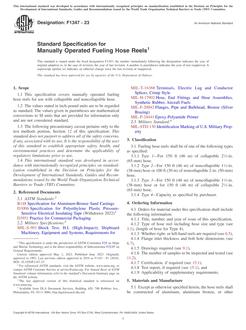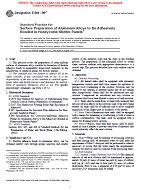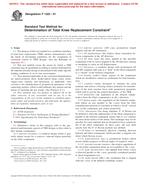1.1 This practice covers a procedure for sampling of cohesive, organic, or fine-grained soils, or combination thereof, using a thin-walled metal tube that is inserted into the soil formation by means of a hydraulically operated piston. It is used to collect relatively undisturbed soil samples suitable for laboratory tests to determine structural and chemical properties for geotechnical and environmental site characterizations.
1.1.1 Guidance on preservation and transport of samples in accordance with Practice D 4220 may apply. Samples for classification may be preserved using procedures similar to Class A. In most cases, a thin-walled tube sample can be considered as Class B, C, or D. Refer to Guide D 6286 for use of the hydraulically operated stationary piston soil sampler for environmental site characterization. This sampling method is often used in conjunction with rotary drilling methods such as fluid rotary; Guide D 5783; and hollow stem augers, Practice D 6151. Sampling data should be reported in the substance log in accordance with Guide D 5434.
1.2 The hydraulically operated stationery piston sampler is limited to soils and unconsolidated materials that can be penetrated with the available hydraulic pressure that can be applied without exceeding the structural strength of the thin-walled tube. This standard addresses typical hydraulic piston samplers used on land or shallow water in drill holes. The standard does not address specialized offshore samplers for deep marine applications that may or may not be hydraulically operated. This standard does not address operation of other types of mechanically advanced piston samplers.
1.3 This practice does not purport to address all the safety concerns, if any, associated with its use and may involve use of hazardous materials, equipment, and operations. It is the responsibility of the user to establish and adopt appropriate safety and health practices. Also, the user must comply with prevalent regulatory codes, such as OSHA (Occupational Health and Safety Administration) guidelines, while using this practice. For good safety practice, consult applicable OSHA regulations and other safety guides on drilling.
1.4 The values stated in SI units or inch-pound units are to be regarded separately as standard. The values stated in each system may not be exact equivalents; therefore, each system shall be used independently of the other. Combining values from the two systems may result in nonconformance with the standard.
1.5 This practice offers a set of instructions for performing one or more specific operations. This document cannot replace education or experience and should be used in conjunction with professional judgement. Not all aspects of this practice may be applicable in all circumstances. This ASTM standard is not intended to represent or replace the standard of care by which the adequacy of a given professional service must be judged, nor should this document be applied without consideration of a project’s many unique aspects. The word “Standard” in the title means only that the document has been approved through the ASTM consensus process. This practice does not purport to comprehensively address all of the methods and the issues associated with sampling of soil. Users should seek qualified professionals for decisions as to the proper equipment and methods that would be most successful for their site investigation. Other methods may be available for drilling and sampling of soil, and qualified professionals should have flexibility to exercise judgment as to possible alternatives not covered in this practice. The practice is current at the time of issue, but new alternative methods may become available prior to revisions, therefore, users should consult with manufacturers or producers prior to specifying program requirements.
Product Details
- Published:
- 07/01/2005
- Number of Pages:
- 7
- File Size:
- 1 file , 120 KB
- Redline File Size:
- 2 files , 230 KB


